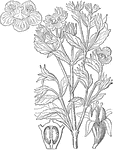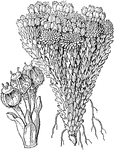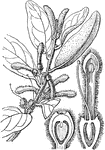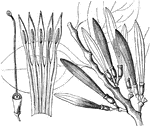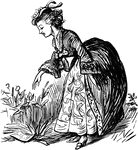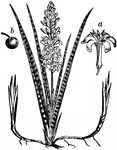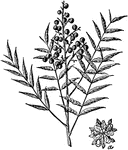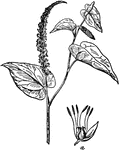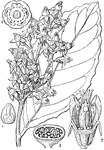
Byrsanthus
"Byrsanthus Brownii. 1. diagram of the flower; 2. section of a flower; 3. section across the ovary;…

Cactus
"Cereus speciosissimus. 1. section of the fruit of Opuntia deillenii; 2. of the seed; 3. section of…
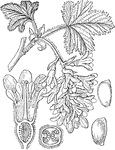
Redcurrant
"Ribes rubrum. 1. perpendicular section of a flower; 2. cross section of the ovary; 3. seed; 4. a perpendicular…
Escallonia
"Escallonia pulverulenta. 1. a flower; 2. a cross section of the ovary; 3. fruit; 4. seed; 5. its perpendicular…
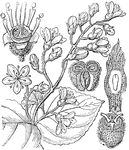
Deutzia
"Deutzia crenata. 1. a flower with the petals removed; 2. a fruit; 3. a portion of the same, showing…
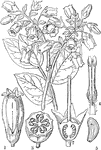
Large-Cluster Blueberry
"Vaccinium amoenum. 1. a flower; 2. a perpendicular section of it without the corolla; 3. a cross section…
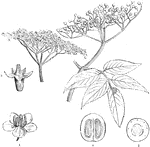
Elder
"Sambucus nigra; 1. a flower; 2. a young pistil; 3. a cross section of its ovary; 4. a perpendicular…
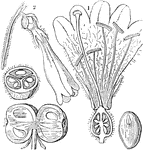
Twinflower
"1. flower of Linnaea borealis; 2. the same cut open and showing the interior of the ovary; 3. a cross…
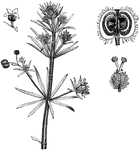
Cleavers
"Galium Aparine; 1. a flower; 2. a young fruit without the corolla; 3. a perpendicular section of a…

Athamantha
"Athamanta cervariaefolia. 1. a separate flower, with hairy petals; 2. a petal by itself; 3. a ripe…
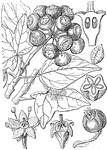
Ivy
"1. Hedera Helix; 2. a flower of Dimorphanthus edulis; 3. perpendicular section of the ovary; 4. undivided…
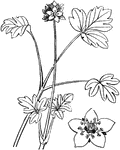
Moschatel
The flower and plant of the moschatel or Adoxa moschatellina, a flowering plant in the Adoxaceae family.

Dogwood
"Benthamia japonica. 1. a flower; 2. a perpendicular section of the pistil; 3. a head of fruit; 4. a…

Winter Hazel
"Corylopsis. 1. flowers; 2. branch in fruit; 3. a flower separate; 4. a stamen; 5. a perpendicular section…

Butttonbush
"Brunia japonica. 1. a flower; 2. a perpendicular section of the pistil; 3. a head of fruit; 4. a section…
Native Currant
"Leptomeria acida; 2. a branch more magnified; 3. an expanded flower; 4. a fruit." -Lindley, 1853
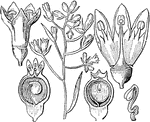
Thesium
"Thesium pratense. 1. a flower; 2. the same laid open; 3. half an unripe fruit; 4. placenta and pair…
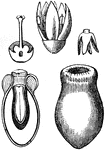
Struthanthus
"Details of the fructification of Struthanthus. 1. flower magnified; 2. section of calyx, ovary, and…

Mottled Dutchman's Pipe
"Aristolochia galeata. 1. fruit of an Aristolochia; 2. cross section of it; 3. half its seed." -Lindley,…

Bragantia
"Bragantia Blumei. 1. a section of its wood; 2. one of its flowers; 3. a seed; 4. the same divided perpendicularly;…
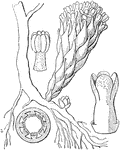
Cytinus
"Cytinus Hypocistis. 1. A flower; 2. a head of anthers; 3. a transverse section of the ovary." -Lindley,…

Centrolepis
"Centrolepis fascicularis. 1. A head of flowers; 2. a single flower separated; 3. an ovary with the…

Potamogetonaceae
"Zannichellia palustris. 1. A flower; 2. a cluster of ripe ovaries; 3. an ovary opened to exhibit the…
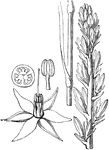
Mardja
"Haemodorum spicatum. 1. A flower spread open; 2. a cross section of the ovary; 3. an anther." -Lindley,…

Sauvagesia
"Lavradia Vellozii. 1. an expanded flower; 2. the stamens with exterior petaloid scales; 3. a seed;…

Turnera
"Turnera genistoides. 1. a flower cut open; 2. a section of the ovary; 3. a seed; 4. a section of it."…

Toothbrush Tree
"Branch with flowers of Salvadora persica. (a), a female flower; (b), the fruit." -Whitney, 1911
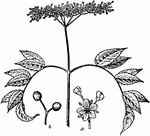
American Elderberry
"Branch with Inflorescence of Elder (Sambucus Canadensis). (a), part of the inflorescence; (b), fruits."…

Rock Samphire
"Upper part of stem with the inflorescence of Samphire (Crithmum maritimum). (a), a flower; (b), the…

Maryland Black Snakeroot
"Flowering plant of sanicle (Sanicula marilandica). (a), a male flower; (b), the fruit." -Whitney, 1911
![Smilax is a genus of about 300-350 species, found in the tropics and subtropics worldwide. In China for example about 80 are found (39 of which are endemic), while there are 20 in North America north of Mexico[1]. They are climbing flowering plants, many of which are woody and/or thorny, in the monocotyledon family Smilacaceae, native throughout the tropical and warm temperate regions of the world. Common names include catbriers, greenbriers, prickly-ivys and smilaxes. "Sarsaparilla" (also zarzaparrilla, sarsparilla) is a name used specifically for the Jamaican S. regelii as well as a catch-all term in particular for American species. Occasionally, the non-woody species such as the Smooth Herbaceous Greenbrier (S. herbacea) are separated as genus Nemexia; they are commonly known by the rather ambiguous name "carrion flowers"](https://etc.usf.edu/clipart/57000/57029/57029_smilax_mth.gif)
Smilax
Smilax is a genus of about 300-350 species, found in the tropics and subtropics worldwide. In China…

Greasewood
"Greasewood (Sarcobatus vermiculatus). 1, with female flowers; 2, branch with fruits; a, a female flower;…

Summer Savory
The Summer Savory (Satureja hortensis) is a flowering plant of the Lamiaceae family. The image shows…

Early Saxifrage
"Flowering plant of saxifrage (Saxifraga virginiensis). a, a flower; b, the fruit." -Whitney, 1911
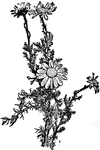
Chamomile
The name Chamomile or Camomile means "earth-apple", because of the applelike scent of the plant. It…
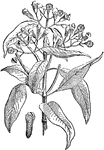
Clove Plant and Seed
Cloves (Syzygium aromaticum, syn. Eugenia aromaticum or Eugenia caryophyllata) are the aromatic dried…
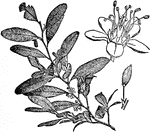
Coca Flower
Coca is a plant in the family Erythroxylaceae, native to north-western South America. The plant plays…

Anamirta cocculus Flowers
An illustration of an anamirta cocculus branch with flowers. Anamirta cocculus is an Southeast Asian…
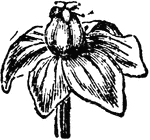
Anamirta cocculus Flower (Female)
An illustration of an anamirta cocculus female flower. Anamirta cocculus is an Southeast Asian and Indian…

Anamirta cocculus Flower (Female)
An illustration of an anamirta cocculus fruit. Anamirta cocculus is an Southeast Asian and Indian climbing…
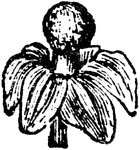
Anamirta cocculus Flower (Male)
An illustration of an anamirta cocculus male flower. Anamirta cocculus is an Southeast Asian and Indian…
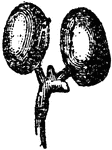
Anamirta cocculus Fruit
An illustration of an anamirta cocculus male flower with the sephals removed. Anamirta cocculus is an…
Cocoanut Palm Spadix
An illustration of a cocoanut palm's spadix. In botany, a spadix (pl. spadices) is a type of spike:…

Scammony
The scammony (Convolvulus scammonia) is a flowering plant of the bindweed family. R, the root.

Dahlia
An illustration of a single dahlia flower. Dahlia is a genus of bushy, tuberous, perennial plants native…
